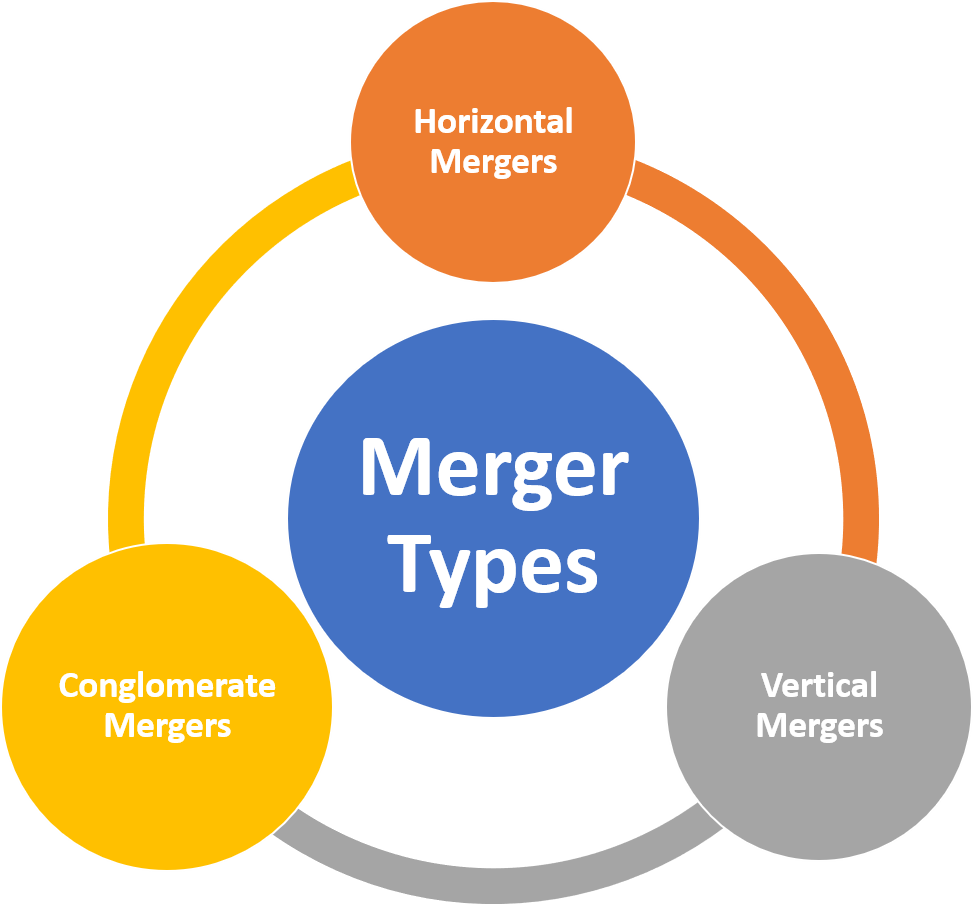Merger is an attempt by the company to build-up scale so that they cannot be acquired by other companies. Many times they are blocked or done subject to fulfilment of conditions. The Indian market is full with examples of mergers like the one between Polyolefin Industries with NOCIL, Sandoz (India) Ltd with Hindustan Ciba Geigy, etc.
Types of Mergers
Mergers can be of the following types:

Horizontal Mergers: A horizontal merger occurs between two companies which are operating in the same industry and often in the same market space. This type of mergers happens in an industry which has very few firms. As a result of this there is intense rivalry between the firms. A merger in this case is beneficial because of the synergy created and also the gains in the market share that can be realised. The objective of a horizontal merger is to create a greater organisation. It can also combine manufacturing, reduce excess capacity and create greater value for customers. For example, a merger between Idea and Vodafone in the Indian telecommunication market could be an idea of a horizontal merger. The combined entity could leverage on the competencies of both Idea and Vodafone. It could also share a lot of common infrastructure like towers, manpower, etc.
Vertical Mergers: Vertical mergers do not aim to increase sales or revenue, but Instead to bring in greater efficiency in management or reduction in costs. A vertical merger occurs when two companies which were earlier engaging as customers and sellers, merge with one another. These companies are usually at different stages Of the production cycle. An example of this when a manufacturer decides to get into the manufacture of the raw materials or inputs to its manufacturing process. Vertical merger is of two types:
- Forward Integration: The firm acquires a customer.
- Backward Integration: The firm acquires a supplier.
Conglomerate Mergers: Conglomerate mergers can be of many types ranging from short term Joint ventures to total mergers. In its purest form or when it is case of geographical extension or product line extension, the merger involves firms that are involved in totally different markets. Therefore, there is no impact on the competitive scenario Of the industry. Conglomerate mergers help the management to improve efficiency and reduce overhead costs. It also forces the managers to increase their efficiencies. Through a conglomerate merger the firm can participate on the supply side or on the demand side in the market place. For example, the merger of Procter and Gamble and Gillette in 2005 allowed to add Gillette’s range Of shaving products to its product portfolio to create greater value for its customers.
Advantages of Mergers
Economies of Scale: Mergers lead to the increase in scale of operations of the organisation. This reduces the per-unit cost. The different economies of scale that can arise are:
- Technical Economies: If the firm has a larger proportion of fixed costs then these get spread over a larger Output, hence bringing down the per unit fixed cost.
- Bulk Buying: The organisation gets a discount because it now buys raw material in bubulk from its suppliers.
- Financial: Since it becomes a bigger institution, it gets a better rate of interest from financial institutions.
- Organisational: Reduction in head office from two to one also saves costs. Economies Of scale benefit horizontal mergers more than vertical mergers.
International Competition: Mergers can help firm counter the threat Of MNCS as they become larger in size With sufflcient resources to take on new competition.
Mergers may allow Greater Investment in R&D: Mergers can lead to better and greater investment in R&D. This is because the company can plough back the greater profits into R&D.
Greater Efficiency: The organisations gains from greater efficiencies if the duplication and redundant activities are removed.
Disadvantages of Mergers
Integration Difficulties: Since a merger of the two companies also means a merger of the two distinct cultures, the integration becomes a very big issue. This is particularly so when there are major differences in the managernent style, employee profile. Dealing With such circumstances becomes a very big issue.
Inadequate Evaluation of Target: The acquiring company in its zest to acquire does not do a valuation of the target company’s assets and liabilities. This often ends up in the form of a bigger premium paid for the assets of the company as against their worth.
Inability to Achieve: The merger also fails because the intended synergy never happens because of reasons like employee non participation, managerial bottlenecks, scepticism, etc.
Too much Diversification: Mergers can also lead to over diversification, which has drawbacks of its own.
Too Large: Increased size has its own inherent limitations. Achieving consistency in terms of decisions and actions may be difficult. Formalised rules and policies may come in the way of flexibility and innovation. The merger can also create problems for the organisation in the sense that it becomes too large. This impacts its decision making and it becomes a victim Of its size. This hampers flexibility and creativity.